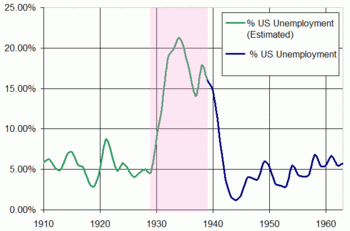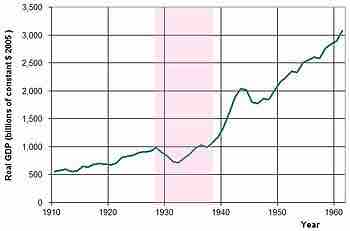The Great Depression was a severe worldwide economic depression in the decade preceding World War II. It was the longest, most widespread, and deepest depression of the 20th century. In the 21st century, the Great Depression is commonly used as an example of how far the world's economy can decline. The depression originated in the U.S., after the fall in stock prices that began around September 4, 1929, and became worldwide news with the stock market crash of October 29, 1929 (known as Black Tuesday).
Cities all around the world were hit hard, especially those dependent on heavy industry. Construction was virtually halted in many countries. Farming and rural areas suffered as crop prices fell by approximately 60%. Facing plummeting demand with few alternate sources of jobs, areas dependent on primary sector industries such as cash cropping, mining, and logging suffered the most. Some economies started to recover by the mid-1930s. In many countries, the negative effects of the Great Depression lasted until the end of World War II.

Great Depression in Unemployment
Unemployment rate in the US 1910–1960, with the years of the Great Depression (1929–1939) highlighted; accurate data begins in 1939.

Great Depression in GDP
USA annual real GDP from 1910 to 1960, with the years of the Great Depression (1929–1939) highlighted.
The New Deal was a series of economic programs enacted in the United States between 1933 and 1936. The programs were in response to the Great Depression, and focused on what historians call the "3 Rs": Relief, Recovery, and Reform. That is, Relief for the unemployed and poor; Recovery of the economy to normal levels; and Reform of the financial system to prevent a repeat depression.
The New Deal produced a political realignment, making the Democratic Party the majority (as well as the party that held the White House for seven out of nine Presidential terms from 1933 to 1969). Its basis was liberal ideas, the white South, traditional Democrats, big city machines, and the newly empowered labor unions and ethnic minorities. The Republicans were split, with conservatives opposing the entire New Deal as an enemy of business and growth, and liberals accepting some of it and promising to make it more efficient. The realignment crystallized into the New Deal Coalition that dominated most presidential elections into the 1960s, while the opposing Conservative Coalition largely controlled Congress from 1937 to 1963.
From 1934 to 1938, Roosevelt was assisted in his endeavors by a "pro-spender" majority in Congress. Many historians distinguish a "First New Deal" (1933–34) and a "Second New Deal" (1935–38), with the second one being more liberal and more controversial. It included a national work program, the Works Progress Administration (WPA), which made the federal government by far the largest single employer in the nation. The "First New Deal" (1933–34) dealt with diverse groups, from banking and railroads to industry and farming, all of which demanded help for economic survival. The Federal Emergency Relief Administration, for instance, provided $500 million for relief operations by states and cities, while the short-lived CWA (Civil Works Administration) gave localities money to operate make-work projects in 1933-34.
The "Second New Deal" in 1935–38 included the Wagner Act to promote labor unions, the Works Progress Administration (WPA) relief program, the Social Security Act, and new programs to aid tenant farmers and migrant workers. The final major items of New Deal legislation were the creation of the United States Housing Authority and Farm Security Administration, both in 1937, and the Fair Labor Standards Act of 1938, which set maximum hours and minimum wages for most categories of workers.
The economic downturn of 1937–38, and the bitter split between the AFL and CIO labor unions, led to major Republican gains in Congress in 1938. Conservative Republicans and Democrats in Congress joined in the informal Conservative Coalition. By 1942–43 they shut down relief programs such as the WPA and CCC and blocked major liberal proposals. Roosevelt himself turned his attention to the war effort, and won reelection in 1940 and 1944. The Supreme Court declared the National Recovery Administration (NRA) and the first version of the Agricultural Adjustment Act (AAA) unconstitutional, although the AAA was rewritten and then upheld. As the first Republican president elected after FDR, Dwight D. Eisenhower (1953–61) left the New Deal largely intact, even expanding it in some areas. In the 1960s, Lyndon B. Johnson's Great Society used the New Deal as inspiration for a dramatic expansion of liberal programs, which Republican Richard M. Nixon generally retained. After 1974, however, the call for deregulation of the economy gained bipartisan support. The New Deal regulation of banking (Glass–Steagall Act) was suspended in the 1990s. Many New Deal programs remain active, with some still operating under the original names, including the Federal Deposit Insurance Corporation (FDIC), the Federal Crop Insurance Corporation (FCIC), the Federal Housing Administration (FHA), and the Tennessee Valley Authority (TVA). The largest programs still in existence today are the Social Security System and the Securities and Exchange Commission (SEC).